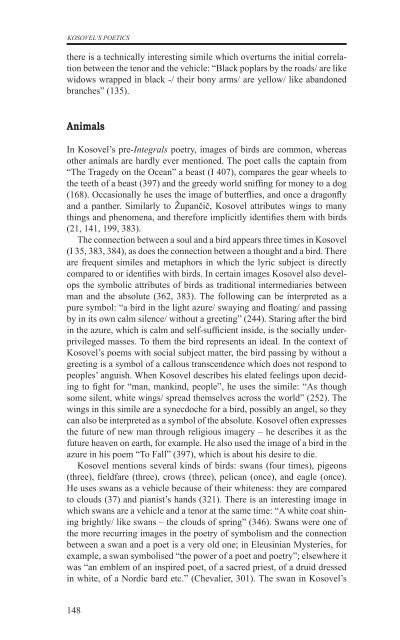razprave (pdf) - Društvo za primerjalno književnost - ZRC SAZU
razprave (pdf) - Društvo za primerjalno književnost - ZRC SAZU
razprave (pdf) - Društvo za primerjalno književnost - ZRC SAZU
- No tags were found...
You also want an ePaper? Increase the reach of your titles
YUMPU automatically turns print PDFs into web optimized ePapers that Google loves.
KOSOVEL’s poeticsthere is a technically interesting simile which overturns the initial correlationbetween the tenor and the vehicle: “Black poplars by the roads/ are likewidows wrapped in black -/ their bony arms/ are yellow/ like abandonedbranches” (135).AnimalsIn Kosovel’s pre-Integrals poetry, images of birds are common, whereasother animals are hardly ever mentioned. The poet calls the captain from“The Tragedy on the Ocean” a beast (I 407), compares the gear wheels tothe teeth of a beast (397) and the greedy world sniffing for money to a dog(168). Occasionally he uses the image of butterflies, and once a dragonflyand a panther. Similarly to Župančič, Kosovel attributes wings to manythings and phenomena, and therefore implicitly identifies them with birds(21, 141, 199, 383).The connection between a soul and a bird appears three times in Kosovel(I 35, 383, 384), as does the connection between a thought and a bird. Thereare frequent similes and metaphors in which the lyric subject is directlycompared to or identifies with birds. In certain images Kosovel also developsthe symbolic attributes of birds as traditional intermediaries betweenman and the absolute (362, 383). The following can be interpreted as apure symbol: “a bird in the light azure/ swaying and floating/ and passingby in its own calm silence/ without a greeting” (244). Staring after the birdin the azure, which is calm and self-sufficient inside, is the socially underprivilegedmasses. To them the bird represents an ideal. In the context ofKosovel’s poems with social subject matter, the bird passing by without agreeting is a symbol of a callous transcendence which does not respond topeoples’ anguish. When Kosovel describes his elated feelings upon decidingto fight for “man, mankind, people”, he uses the simile: “As thoughsome silent, white wings/ spread themselves across the world” (252). Thewings in this simile are a synecdoche for a bird, possibly an angel, so theycan also be interpreted as a symbol of the absolute. Kosovel often expressesthe future of new man through religious imagery – he describes it as thefuture heaven on earth, for example. He also used the image of a bird in theazure in his poem “To Fall” (397), which is about his desire to die.Kosovel mentions several kinds of birds: swans (four times), pigeons(three), fieldfare (three), crows (three), pelican (once), and eagle (once).He uses swans as a vehicle because of their whiteness: they are comparedto clouds (37) and pianist’s hands (321). There is an interesting image inwhich swans are a vehicle and a tenor at the same time: “A white coat shiningbrightly/ like swans – the clouds of spring” (346). Swans were one ofthe more recurring images in the poetry of symbolism and the connectionbetween a swan and a poet is a very old one; in Eleusinian Mysteries, forexample, a swan symbolised “the power of a poet and poetry”; elsewhere itwas “an emblem of an inspired poet, of a sacred priest, of a druid dressedin white, of a Nordic bard etc.” (Chevalier, 301). The swan in Kosovel’s148
















